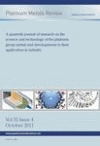-
oa Dispersion Strengthened Platinum
Properties and Characteristics of a New High Temperature Material
- Source: Platinum Metals Review, Volume 18, Issue 2, Apr 1974, p. 46 - 57
-
- 01 Jan 1974
- Previous Article
- Table of Contents
- Next Article
Abstract
Platinum can be strengthened very effectively for high temperature use by the addition of small quantities of a highly dispersed non-metallic phase, and recent work in the Johnson Matthey Research Laboratories has established processes which allow such a composite material to be produced consistently and reliably on an industrial scale. The new material, known commercially as ZGS platinum, is significantly stronger and more creep resistant than the conventional high temperature rhodium-platinum alloys, and yet retains the traditional characteristics which have given platinum its unique role in many industrial applications. This article describes the physical and mechanical properties of this dispersion strengthened product, highlights some of the areas in which it has been employed to advantage and discusses design factors in such uses.


